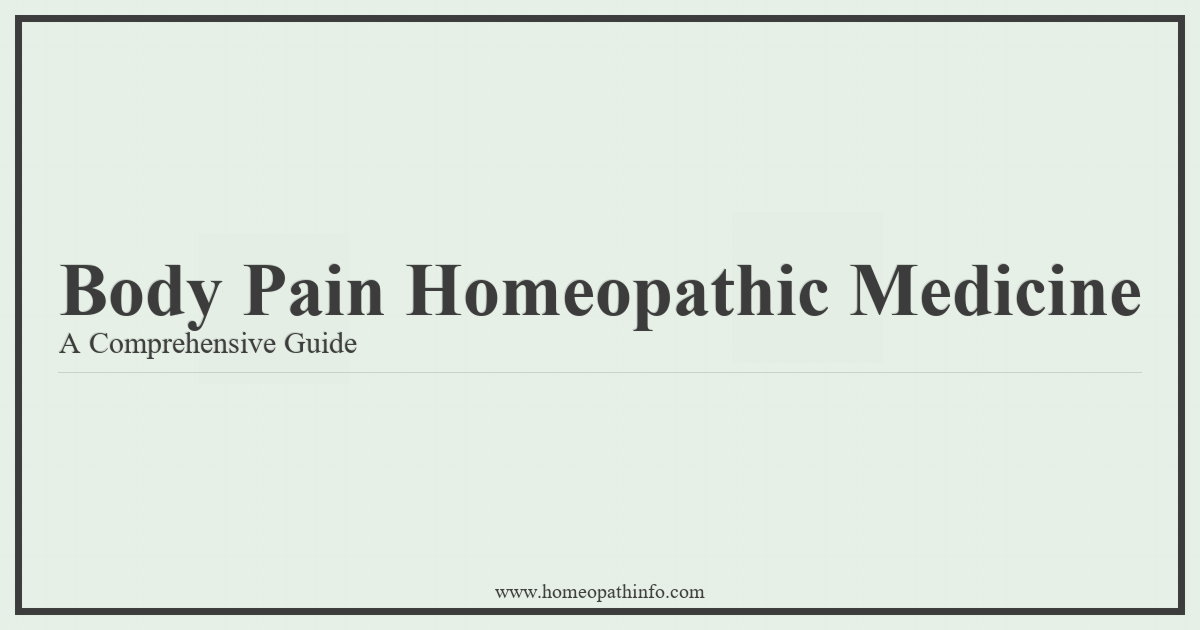1. Introduction
“Pain is inevitable. Suffering is optional.” – Buddhist proverb
Body Pain Homeopathic Medicine – In a world where chronic pain affects millions, many are seeking alternatives to conventional treatments. Homeopathic medicine for body pain offers a gentle, holistic approach that’s gaining popularity. But can these tiny pills really tackle your aches and pains?
Key Takeaways:
- Homeopathy is a natural, holistic approach to pain management
- It aims to stimulate the body’s self-healing mechanisms
- Several homeopathic remedies are used for various types of body pain
- Lifestyle changes are crucial alongside any treatment
- Scientific evidence for homeopathic pain treatments is limited
- Always consult healthcare professionals before starting any new treatment
2. Understanding Body Pain Homeopathic Medicine
Definition:
Body pain homeopathic medicine involves using highly diluted substances to stimulate the body’s natural healing processes, aiming to alleviate various types of pain.
Causes and Risk Factors:
- Injuries or overuse
- Chronic conditions (e.g., arthritis, fibromyalgia)
- Stress and tension
- Poor posture
- Nutritional deficiencies
- Age-related degeneration
Symptoms:
- Localized or widespread pain
- Stiffness in joints or muscles
- Reduced range of motion
- Fatigue
- Sleep disturbances
- Mood changes
3. Body Pain Homeopathic Medicine Approach
Principles of the Approach:
- Individualization: Treatments tailored to each person’s unique symptoms
- Minimum dose: Using highly diluted substances
- Like cures like: Substances that cause symptoms in healthy people may treat similar symptoms in sick individuals
Benefits:
- Holistic treatment addressing overall health
- Potentially fewer side effects than conventional pain medications
- May complement lifestyle changes
- Aims to stimulate the body’s self-healing mechanisms
- Non-invasive approach
- Can be used alongside conventional treatments (with proper guidance)
4. Popular Remedies/Treatments for Body Pain Homeopathic Medicine
| Remedy | Primary Indications | Key Symptoms |
|---|---|---|
| Arnica montana | Bruising, trauma | Soreness, “beaten” feeling |
| Rhus toxicodendron | Joint pain | Stiffness, better with movement |
| Bryonia alba | Sharp pains | Worse with movement |
| Ruta graveolens | Ligament/tendon pain | Weakness, bruised feeling |
5. Body Pain Homeopathic Medicine Specific Section
Identifying the Right Treatment/Approach:
A qualified homeopath typically conducts a detailed consultation, considering:
- Pain characteristics (sharp, dull, throbbing)
- Factors that improve or worsen the pain
- Associated symptoms
- Overall health history
Dosage and Administration:
- Common potencies: 6C, 30C, or 200C
- Typically taken as sublingual pellets or drops
- Frequency varies based on individual case and potency
- Always follow the homeopath’s or product instructions
6. Complementary Therapies
- Acupuncture: May help reduce pain and inflammation
- Massage therapy: Can relieve muscle tension and improve circulation
Exercise Suggestions:
- Gentle stretching: Improves flexibility and reduces stiffness
- Low-impact aerobic activities: Swimming, walking, or cycling
- Yoga or Tai Chi: Combines movement with mindfulness
7. Lifestyle Modifications
Stress Reduction Techniques:
- Meditation and mindfulness practices
- Deep breathing exercises
- Progressive muscle relaxation
- Regular physical activity
Rest and Recovery Tips:
- Ensure adequate sleep (7-9 hours nightly)
- Use proper ergonomics at work and home
- Take regular breaks from prolonged sitting or repetitive activities
Nutritional Considerations:
- Anti-inflammatory diet rich in fruits, vegetables, and omega-3 fatty acids
- Stay hydrated
- Consider supplements like turmeric or fish oil (consult a healthcare provider first)
8. Prevention
Tips for preventing body pain:
- Maintain good posture
- Exercise regularly to strengthen muscles
- Use proper lifting techniques
- Stay hydrated and eat a balanced diet
- Manage stress effectively
- Get regular check-ups and address health issues promptly
9. When to Seek Professional Help
Signs that indicate professional intervention is needed:
- Severe or persistent pain
- Pain accompanied by other symptoms (fever, unexplained weight loss)
- Pain that interferes with daily activities
- Numbness, tingling, or weakness
- Pain following an injury or accident
10. Success Stories
Note: These are hypothetical examples and not scientific evidence
Case 1: Sarah, 45, reported significant reduction in her chronic back pain after three months of homeopathic treatment combined with yoga practice.
Case 2: John, 60, experienced improved mobility and reduced joint pain after using homeopathic remedies alongside dietary changes for his arthritis.
11. Integrating Body Pain Homeopathic Medicine Approach with Conventional Treatment
Homeopathy can potentially complement conventional pain management strategies but should never replace medical advice or prescribed medications.
| Aspect | Conventional Approach | Homeopathic Approach |
|---|---|---|
| Focus | Symptom management, medication | Holistic treatment, stimulating self-healing |
| Speed of Action | Often faster | May take longer to see effects |
| Side Effects | Can be significant | Claimed to be minimal |
| Scientific Evidence | Extensive research support | Limited scientific evidence |
| Personalization | Standardized protocols | Highly individualized |
12. Myths and Misconceptions
- Myth: Homeopathy can cure all types of pain instantly. Reality: Treatment takes time and may not be effective for all conditions.
- Myth: Homeopathic remedies have no side effects. Reality: While generally considered safe, any substance can potentially cause reactions.
- Myth: Higher potencies are always more effective. Reality: The appropriate potency depends on individual factors and the condition being treated.
- Myth: Homeopathy is just placebo. Reality: While scientific evidence is limited, some individuals report benefits beyond placebo effects.
13. Choosing a Qualified Practitioner
Tips for Selecting a Homeopath:
- Check for proper certification and licensing
- Look for membership in professional homeopathic associations
- Ask about their experience with pain management
- Ensure they’re willing to work alongside your conventional healthcare providers
Qualifications to Look For:
- Formal training from an accredited homeopathic program
- Continuing education in homeopathy
- Background in health sciences (e.g., medicine, nursing)
14. Future Outlook
The future of homeopathy in pain management remains uncertain:
- More rigorous scientific studies are needed to evaluate efficacy
- Integration with conventional medicine may evolve
- Personalized medicine approaches might incorporate some homeopathic principles
- Regulatory changes could impact availability and practice
15. Conclusion
While homeopathic medicine for body pain offers a gentle, holistic approach, it’s crucial to approach it with realistic expectations. The cornerstone of pain management remains a multifaceted approach including lifestyle changes, proper medical care, and stress management. Homeopathy may complement these efforts, but should not replace conventional medical advice.
As with any health decision, consult qualified healthcare professionals to create a comprehensive treatment plan tailored to your unique needs. Remember, managing pain is a journey, and finding the right combination of treatments often requires patience and persistence.
16. FAQ
Q1: Is homeopathy scientifically proven to treat body pain? A1: Currently, there’s limited scientific evidence supporting homeopathy for pain management.
Q2: Can I use homeopathy alongside my prescribed pain medications? A2: Possibly, but always inform all your healthcare providers about any treatments you’re using to ensure safe integration.
Q3: How long does it take to see results with homeopathic treatment for pain? A3: Response times vary greatly. Some users report changes within days or weeks, while others may see no effect.
Q4: Are there any side effects of homeopathic remedies for body pain? A4: While generally considered safe, any substance can potentially cause side effects. Consult a healthcare provider before use.
Q5: Can homeopathy prevent chronic pain conditions? A5: There’s no scientific evidence supporting this claim. Lifestyle changes remain the best prevention strategy.
Q6: Is homeopathic treatment for pain safe during pregnancy? A6: Always consult a qualified healthcare professional before using any remedies during pregnancy.
Q7: How is homeopathy different from herbal medicine for pain relief? A7: Homeopathy uses highly diluted substances, while herbal medicine uses plant materials in more substantial quantities.
Q8: Do I need a prescription for homeopathic pain remedies? A8: In many countries, homeopathic remedies are available over-the-counter, but it’s advisable to consult a qualified practitioner.

